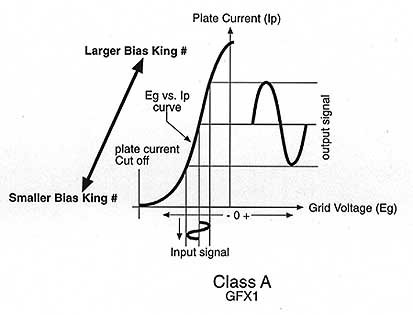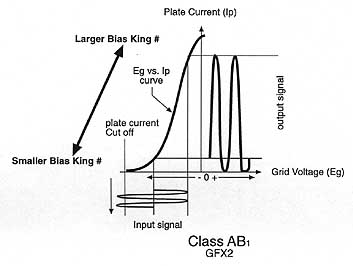|
|
Tech Talk with
Steve Wilson: "Bias" is to your amp like "idle" is to your car. It sets the RANGE or CLASS of operation for the tubes in that amp like the idle sets the range of operation for your engine. The bias is adjusted when the amp is not playing (no signal), and the idle is adjusted when the car is not moving (no motion). Too much current flowing (idle too high, wears parts and wastes fuel) and the amp runs hot and burns up tubes and transformers. Not enough current (idle too low, sluggish take off) and the tubes don't turn on long enough to amplify the signal without a lot of distortion. This gritty, grainy, nasty distortion is easily recognizable once you know what you're listening for. CLASSES OF OPERATION: The class of operation for a tube amp is determined by the amount of time the tube is conducting signal. What determines the amount of time the tube conducts signal? Bias. The two main classes of operation used in guitar amps are class "A" and class "AB1". This discussion will be limited to them. CLASS A: In a class A amp, the tube is biased on the linear part of it's dynamic characteristic curve and the signal driving the grid is small enough so that it remains on the linear part throughout the full cycle. This ensures the output wave form closely resembles the input signal. Since the output is similar to the input, there is little or no distortion. The input signal never drives the grid sufficiently negative to "cut-off" the tube. This allows plate current to flow for the complete cycle. Have you noticed how "hot" a class A amp seems to run? That's because the tube never "shuts off" and is always dissipating a lot of power. This dissipated power is developed across the tube and not the load, and is wasted as far as output power is concerned. This means that class A amps are low efficiency. Also, the amplitude of the input signal is less than the bias voltage, so the grid is never driven positive. This keeps distortion producing grid current from flowing. Class A amps are characterized by the following: - little or no distortion
CLASS AB1: For simplicity, we'll loose the subscript on class AB1 and just call it class AB from now on. In a class AB amp, plate current flows for slightly more than 1/2 of the input signal cycle, but less than the whole cycle. This allows the tube to "turn off" occasionally, and not run as hot as class A. Like class A, the input signal is less than the bias voltage, so no grid current flows. In fact, that's what the subscript "1" stands for - no grid current flow. The bias for class AB is set somewhere between "cutoff" and the linear part of the dynamic transfer characteristic curve. Part of the negative 1/2 cycle of the input signal drives the tube into cutoff, turning it off, and clipping its output signal.
During this part of the cycle where the tube does not conduct, no current flows through the tube. This means it doesn't have to dissipate any power (heat), and cools somewhat. Now, with only 1/2 of the signal present at the output, it's going to sound pretty awful! This is the "Push" of the Push-Pull topology that is always associated with class AB. The "Pull" is the other tube, or set of tubes, which are driven 180 degrees out of phase by the phase inverter . As the Push goes into cut off, the Pull starts conducting. The two signals are mixed in the output transformer and sent to the speaker so we hear a continuous sound. |
|


